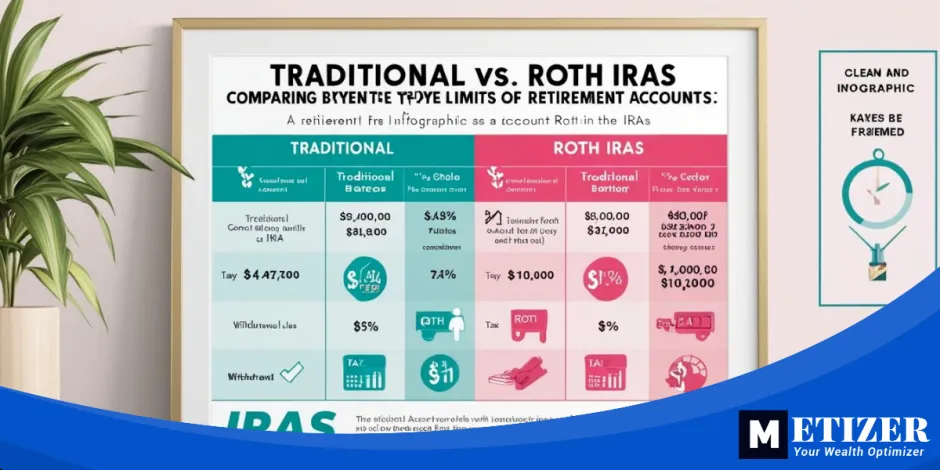Introduction to IRAs and Their Importance
In the labyrinth of retirement planning, few decisions are as pivotal as choosing between a Traditional Individual Retirement Account (IRA) and a Roth IRA. These accounts are more than just savings tools; they are strategic investments in your financial future. Understanding the nuances of each can significantly impact your retirement lifestyle.
What Are IRAs?
IRAs are tax-advantaged investment vehicles designed to help individuals save for retirement. They offer significant benefits, including tax-deferred growth and potential tax-free withdrawals, making them invaluable for retirement planning. However, the choice between a Traditional and Roth IRA hinges on various personal factors.
Key Differences: Traditional vs. Roth IRAs
The primary distinction between these two IRA types lies in their tax treatment.

Tax Timing:
Traditional IRA: Contributions are tax-deductible, reducing your current taxable income. Taxes are deferred until withdrawal, typically in retirement when income might be lower.
Roth IRA: Contributions are made with after-tax dollars, meaning you pay taxes upfront. Withdrawals, including earnings, are tax-free provided certain conditions are met.
Contribution Limits:
Both have the same annual contribution limit for 2023, adjusted for inflation each year. This cap applies to all IRA contributions combined, so mixing Traditional and Roth contributions must stay within the limit.
Income Eligibility:
Roth IRAs have income limits, restricting contributions for high earners. Traditional IRAs have no income limits for contributions but may offer partial or full tax deductions based on income and other factors.
Withdrawal Rules:
Traditional IRA: Withdrawals begin at age 73 with Required Minimum Distributions (RMDs). Early withdrawals (before 59½) may incur penalties.
Roth IRA: No RMDs; you can leave funds in the account indefinitely. Withdrawals are tax-free and penalty-free after five years and if you're 59½ or older.
Who Should Consider a Traditional IRA?
Current Tax Benefits seekers: Ideal for those in higher tax brackets now, expecting lower taxes in retirement.
Individuals with Lower Current Income:Benefit from tax deductions, especially if they don't qualify for Roth due to income limits.
Those Anticipating Lower Future Income: If expecting to retire in a lower tax bracket, the deferred taxes could be more advantageous.
Who Should Consider a Roth IRA?
Those Expecting Higher Future Taxes:If you anticipate a higher tax rate in retirement, paying taxes now preserves more tax-free growth.
Young Investors with Time on Their Side:Long investment horizon enhances tax-free growth benefits.
Those Planning for Bequests:Roth IRAs can be a great inheritance tool as they don't require RMDs during your lifetime.
The Flexibility of Roth IRAs
Roth IRAs offer unparalleled flexibility. Contributions can be withdrawn anytime without tax or penalty. This feature acts as a financial safety net, allowing access to funds without jeopardizing retirement savings.
of Part 1
Deciding between a Traditional and Roth IRA is not a one-size-fits-all decision. It requires a thorough understanding of your current financial situation and future projections. Both options offer unique benefits, and your choice should align with your long-term financial goals and risk tolerance.
Factors Influencing Your IRA Choice: A Deeper Dive
Building on the basics, let's explore the critical factors influencing your decision between a Traditional and Roth IRA.
Age and Time Horizon
Your age plays a significant role in IRA selection. Younger individuals can leverage the Roth IRA's tax flexibility and long-term growth. For example, Sarah, a 30-year-old, expects her income and tax rate to increase. Contributing to a Roth IRA now allows her to benefit from tax-free growth over 30 years, ensuring substantial retirement savings.
In contrast, older individuals nearing retirement may prefer a Traditional IRA if they anticipate a lower tax bracket post-retirement. John, aged 60, expects his income and tax rate to decrease upon retiring. His Traditional IRA contributions now reduce his current taxable income, and he'll pay taxes at a lower rate when withdrawing.
Income Level and Tax Bracket
Current and projected income levels are crucial. If you're in a lower tax bracket now, a Roth IRA's after-tax contributions could be more advantageous. Conversely, if you're in a higher bracket and expect a lower one in retirement, a Traditional IRA's upfront tax deduction might yield greater benefits.
Future Tax Rate Expectations
Predicting future tax rates is challenging, but educated guesses are essential. If you believe tax rates will rise, a Roth IRA's current tax payment secures tax-free growth. However, if expecting lower rates, deferring taxes via a Traditional IRA could be more beneficial.
Investment Goals and Risk Tolerance
Your investment strategy and risk tolerance influence IRA choice. Roth IRAs attract those seeking long-term growth and tax-free income. Traditional IRAs are suited for those comfortable with market volatility and uncertain about future tax rates.
The Role of Employer-Sponsored Plans
If you participate in an employer retirement plan, such as a 401(k), your IRA choice might vary. Employer plans often offer higher contribution limits or employer matches, which should be maximized before considering an IRA.
Diversification and Asset Allocation
Diversification within your IRA is crucial. Utilizing both Roth and Traditional IRAs for different asset classes can balance risk and tax implications. For example, holding volatile assets in a Roth IRA and conservative ones in a Traditional IRA could mitigate tax risks.
Estate Planning Considerations
Roth IRAs offer estate planning benefits, allowing heirs tax-free distributions without RMDs. This feature makes them ideal for passing wealth to future generations.
Special Cases: Conversion from Traditional to Roth IRA
Income-eligible individuals can convert Traditional IRAs to Roth IRAs, paying taxes on converted amounts. This strategy can provide tax-free income in retirement, though it's contingent on your tax situation and goals.
Making Your Decision: A Strategic Approach
Evaluate Current vs. Future Tax Rates:Assess whether you'll be in a higher or lower tax bracket in retirement.
Assess Time Horizon:Long-term investors benefit more from Roth IRAs.
Consider Access Needs:Roth IRAs offer better liquidity for emergency funds or early retirement needs.
Explore Tax Diversification:Maintaining both IRA types can offer flexibility in managing taxable income during retirement.
Choosing between a Traditional and Roth IRA is a strategic financial decision influenced by various factors. By considering your current financial status, future expectations, and long-term goals, you can select the IRA that best suits your needs. Whether opting for the tax deferral of a Traditional IRA or the flexibility of a Roth IRA, both offer pathways to a secure retirement. Consulting with a financial advisor can provide personalized insights, ensuring your retirement strategy aligns with your unique circumstances.
